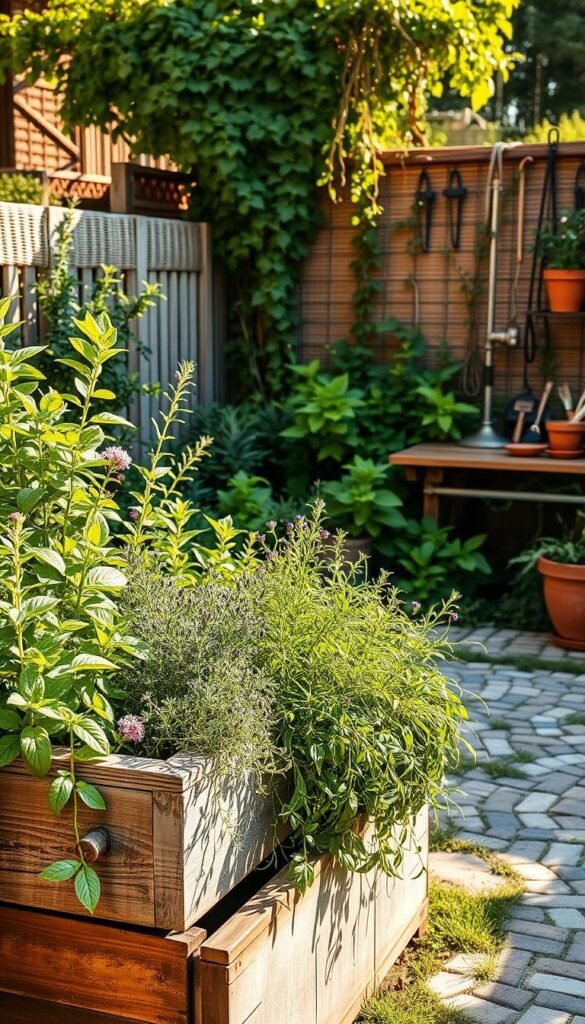Imagine stepping outside to snip fresh basil for your pasta or pluck mint for your iced tea. Growing flavorful plants at home isn’t just practical—it’s a joyful way to connect with nature while elevating everyday meals. Whether you’ve got a sunny backyard or a small kitchen windowsill, cultivating your own green corner is simpler than you might think.
Many beginner-friendly varieties thrive with minimal care. Oregano, thyme, and rosemary adapt well to containers, while parsley and chives flourish in raised beds. These plants do more than add zest to recipes—they attract butterflies and bees, turning your space into a lively ecosystem.
You’ll love the convenience of having ingredients at your fingertips. No more wilted grocery store bundles or last-minute dashes for missing seasonings. Homegrown options retain more nutrients and flavor compared to dried alternatives, making every dish taste brighter.
Starting small pays off quickly. Even a few pots can yield enough for cooking, drying, or sharing with neighbors. As your confidence grows, so can your collection—experiment with lemon balm for teas or lavender for baked goods. The possibilities are as endless as your creativity.
Introduction: Kickstart Your Culinary Herb Journey
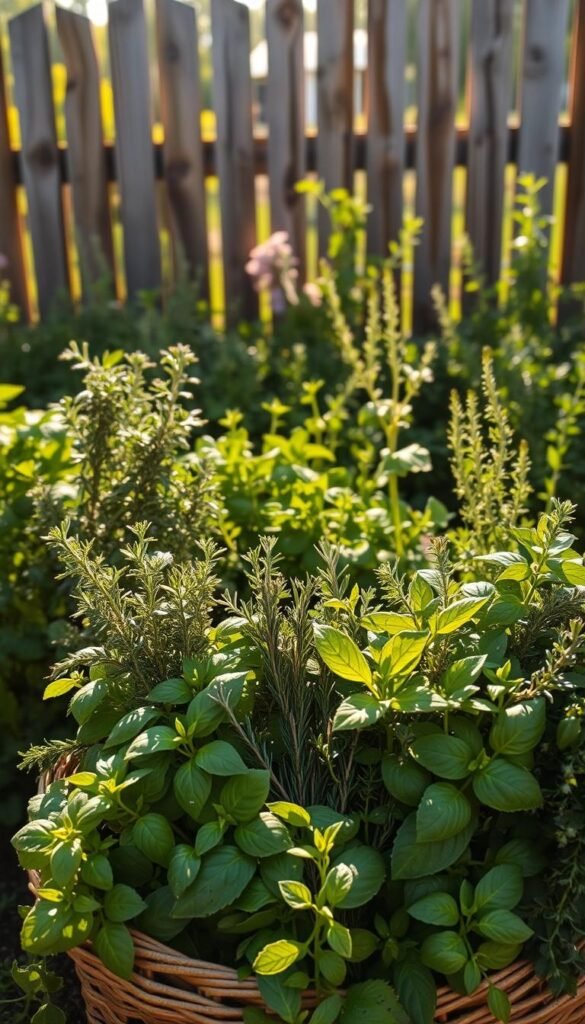
Picture your fingers brushing fragrant leaves as you harvest tonight’s dinner ingredients right outside your door. Growing fresh seasonings transforms ordinary meals into vibrant experiences while connecting you to nature’s rhythms.
Why Your Kitchen Needs Fresh Herbs
Homegrown varieties pack more flavor than store-bought options. A single basil plant can elevate dozens of dishes, from caprese salads to homemade pesto. You’ll notice brighter tastes and aromas in every recipe.
Many herbs thrive with minimal effort, perfect for beginners. Mint grows vigorously in pots, while rosemary tolerates dry spells. These plants double as natural air purifiers, releasing refreshing scents as you brush past them.
Your green space becomes a haven for bees and butterflies. Lavender’s purple spikes or dill’s feathery blooms attract pollinators, supporting local ecosystems. Even small plantings make a difference.
Beyond taste, herbs like thyme and oregano offer health perks. Studies show they contain antioxidants that may boost immunity. Fresh sage adds depth to roasted veggies while delivering over 150 beneficial compounds.
You’ll save money long-term—a $3 starter plant yields months of harvests. Compare that to buying pre-cut bundles weekly. Plus, nurturing plants from seedlings to maturity brings unmatched pride to your cooking adventures.
10 Essential Herb Garden Ideas for Delicious Home Cooking
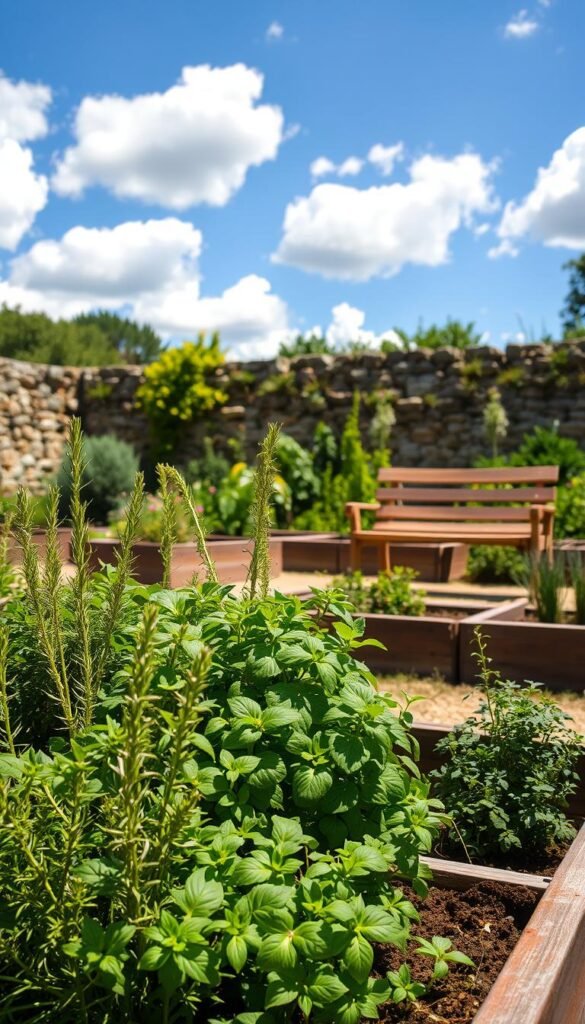
Transform your meals with a handful of fresh-picked flavors from your backyard. Let’s explore standout varieties that thrive in pots or beds, each adding distinct personality to your recipes.
Must-Grow Herbs for Vibrant Cooking
Basil Genovese steals the show with its sweet, peppery leaves. Perfect for pesto or sliced tomatoes, it grows quickly in warm weather. Pair it with chives—their onion-like zing upgrades dips and omelets. Their purple blooms also brighten salads.
Rosemary lovers should try both creeping and Tuscan Blue types. The first spills beautifully from containers, while the latter’s blue flowers add garden drama. Both thrive in sunny spots with minimal watering.
| Herb | Flavor Profile | Best Uses | Growth Tips |
|---|---|---|---|
| Spearmint | Cool, sweet | Teas, desserts | Use pots to control spread |
| Italian Parsley | Bright, earthy | Garnishes, sauces | Partial shade in hot climates |
| Tuscan Blue Rosemary | Pine-like, bold | Roasts, breads | Well-drained soil |
Got kids? Try growing herbs indoors with spearmint or oregano. These forgiving plants make learning fun. Plus, snipping leaves together creates tasty memories.
Mix textures for visual appeal—lacey dill beside bushy basil, or thyme trailing over planter edges. Your herb garden becomes a living spice rack, ready to elevate weeknight dinners or weekend feasts.
Choosing the Perfect Herbs and Containers
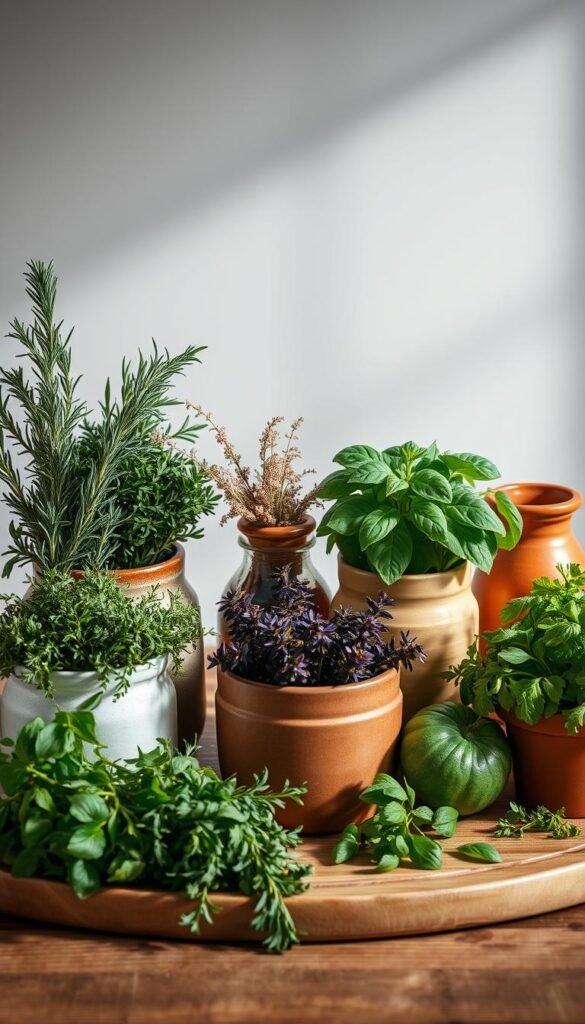
Matching your green companions to their ideal environment ensures lush growth and bold flavors. Start by observing your local weather patterns—does your area bake in summer sun or shiver through frosty winters?
Selecting Herbs That Grow Best for Your Climate
Mediterranean natives like rosemary and thyme thrive in hot, dry climates with mild winters. If you’re in cooler zones, try cold-hardy options such as chives or parsley. Basil and cilantro prefer warmth—move pots indoors when temperatures drop below 50°F.
| Herb | Climate Preference | Container Needs | Pro Tip |
|---|---|---|---|
| Rosemary | Hot & dry | 12″ depth | Add sand to soil mix |
| Basil | Warm & humid | 8″ width | Use plastic pots |
| Thyme | Mild winters | 6″ drainage | Group with sage |
Finding Containers That Promote Healthy Root Growth
Your pots are more than decor—they’re lifelines. Choose containers with at least three drainage holes and 6–8″ width for spreading roots. Line the bottom with gravel to prevent clogs. Terracotta breathes better than plastic, but both work if you water wisely.
Cluster herbs with similar thirst levels. Mint and parsley enjoy moist soil, while oregano and lavender need well-drained soil to avoid soggy roots. Rotate pots in sunny spots to give all plants plenty of light.
Gardening Tips for Optimal Growth and Sunlight
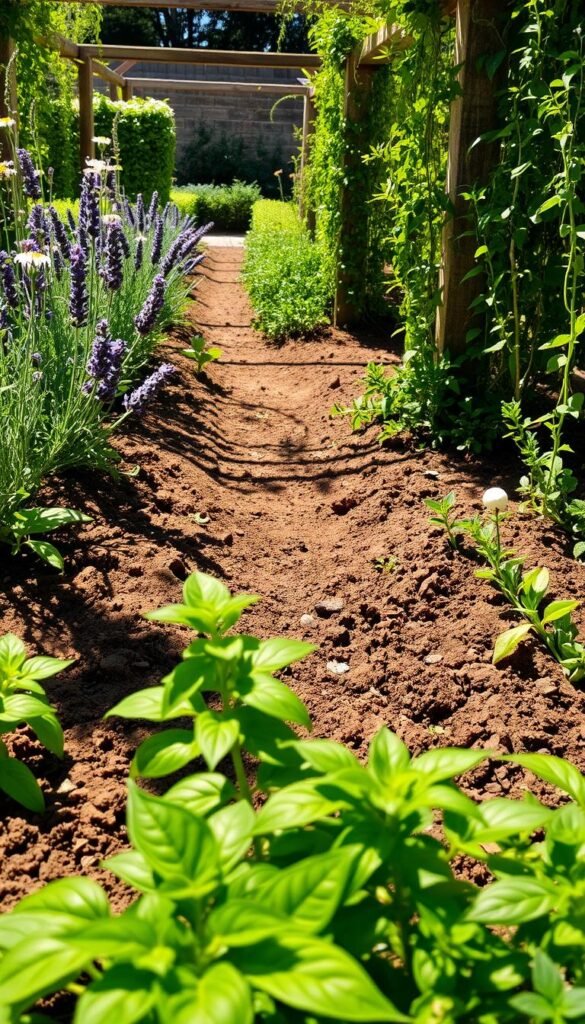
Your herbs’ flavor and vitality begin with smart growing practices. Let’s explore how to create ideal conditions for robust plants that reward you with aromatic leaves all season.
Preparing Well-Drained, Fertile Soil
Start with a peat-free potting mix designed for containers. These blends contain perlite or vermiculite for airflow, preventing soggy roots. Mix in coarse sand for Mediterranean varieties like rosemary—their roots despise standing water.
Test drainage by watering a trial pot. If puddles form on top after 10 minutes, add more grit. Healthy soil should feel crumbly, not dense, when squeezed.
Effective Watering and Fertilization Techniques
Check moisture by sticking your finger 1″ deep. Water only when dry, aiming for the base to keep leaves dry. Morning sessions give plants time to drink before heat hits.
- Use room-temperature water to avoid root shock
- Apply liquid seaweed fertilizer every 2 weeks in spring/summer
- Skip feeding during dormancy (winter)
South-facing windows work in cooler months, but shift pots eastward come summer. Basil and oregano crave 6+ hours of light daily—rotate pots weekly for even growth.
Design Ideas: Creating a Lively and Functional Herb Garden
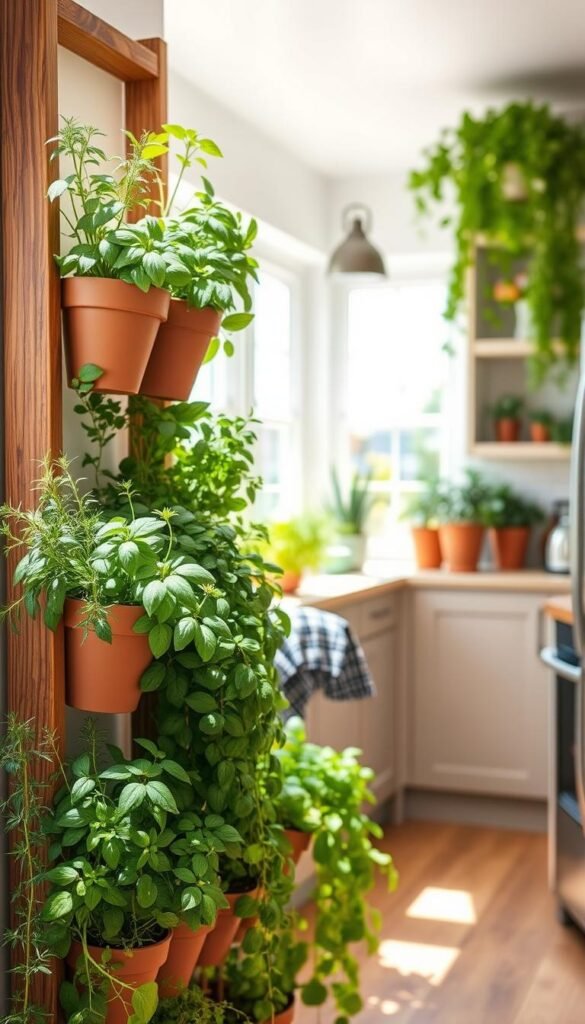
Want fresh flavors at your fingertips without sacrificing style? Smart design turns cramped corners into thriving green spaces. Even apartment dwellers can cultivate aromatic plants that dazzle the eye and spice up meals.
Space-Smart Growing Solutions
Vertical gardens unlock unused wall space while adding visual interest. Try hanging baskets for trailing oregano or wall-mounted pockets for compact basil. Tiered plant stands let you grow mint upstairs and thyme below—all in one square foot.
Sunny windowsills become mini farms with proper planning. Arrange pots by height: chives in back, creeping rosemary up front. South-facing spots work best, but east-facing windows suit shade-tolerant parsley.
Get creative with containers:
- Mason jars with drainage holes
- Vintage colanders lined with moss
- Stacked crates for a rustic look
Group moisture-loving plants like cilantro together. Keep drought-tolerant lavender separate. This “zone gardening” approach simplifies care while preventing overwatering.
Balcony railings offer prime real estate. Use clamp-on planters for sage or marjoram—their silver-green leaves shimmer in sunlight. Add twinkle lights at night for magical ambiance.
Remember: good airflow prevents mold. Leave 2-3 inches between pots. Rotate planters weekly so all sides get equal light. Your living spice rack will stay lush and productive year-round.
Enhancing Your Dishes with Fresh Herbs
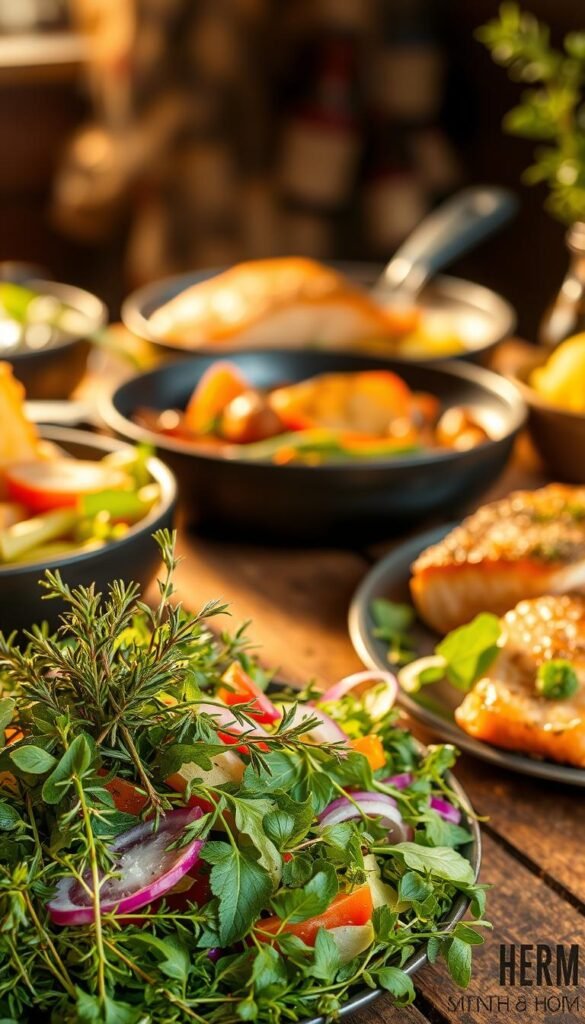
Unlock new dimensions of flavor by weaving homegrown herbs into every meal. These fragrant leaves do more than garnish plates—they spark creativity in your kitchen and redefine what “fresh” truly means.
Beyond Basic Seasonings
Basil transforms ordinary dishes into vibrant masterpieces. Blend it into creamy pesto for pasta, freeze into ice cubes for lemonade, or layer with peaches for unexpected desserts. Its sweet, peppery taste shines in both savory and sweet creations.
Parsley’s bright flavor elevates sauces and marinades. Puree it with garlic for chimichurri or mix into butter for grilled corn. Don’t toss those stems—they add earthy depth to soups when simmered.
Sage becomes crispy magic when fried in olive oil. Sprinkle over pumpkin ravioli or stir into brown butter for nutty pasta sauces. Pair it with ricotta toast or infuse into honey for cheese boards.
| Herb | Unexpected Use | Flavor Boost |
|---|---|---|
| Dill | Yogurt-dill dip | Fresh, tangy |
| Rosemary | Citrus tea infusion | Woodsy, aromatic |
| Fennel | Seared salmon glaze | Licorice-like sweetness |
Rosemary’s piney notes enhance roasted veggies and cocktails. Try it in olive oil for bread dipping or steeped in simple syrup for gin drinks. For year-round freshness, consider growing herbs indoors to maintain your supply.
Mix mint into lamb burgers or blend with pineapple for salsa. Experiment with thyme in honey-glazed carrots or lavender in shortbread cookies. Your dishes will taste like they’re straight from a chef’s kitchen.
Herb Gardening Best Practices from Industry Experts
Keep your plants thriving with simple strategies that balance care and nature’s wisdom. Even herbs grow beginners can master organic pest control and pruning techniques for lush, productive plants.
Organic Pest Control and Pruning for Vibrant Growth
Ditch harsh chemicals by using neem oil spray for aphids or crushed eggshells to deter slugs. Companion planting works wonders—grow marigolds near basil to repel beetles. For easiest herbs like mint, pinch off flower buds to redirect energy into leaf production.
Prune regularly to prevent leggy growth. Snip stems just above leaf nodes using clean shears. This encourages bushier plants and more harvests. Herbs in partial shade like parsley need less frequent trimming than sun-loving varieties.
Struggling with mildew? Improve airflow by spacing pots and watering at the base. Grow beginners often over-love their plants—let soil dry slightly between waterings. Try lemon thyme or other fragrant herb varieties that naturally deter pests while perfuming your space.
Remember: healthy roots mean flavorful leaves. Repot overcrowded plants every spring using fresh soil. With these tips, your herb grow journey stays rewarding season after season.

